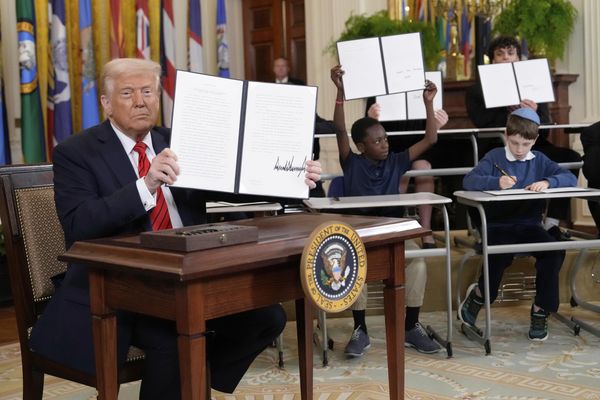The biggest reason for optimism that a Federal Reserve-induced recession can be avoided next year just got revised away. Upward revisions to hourly pay in September and October and an even bigger jump in November lifted wage growth far above the range consistent with the Fed's 2% inflation target.
A near-consensus is emerging that the only hope of the U.S. economy avoiding a hard landing and bigger drop for the S&P 500 is for the Fed to raise its inflation target — at least in practice. The Fed may be willing to do so, but would still need to see some further cooling before ending its rate hikes.
The 2% inflation target "is a lot more elastic than the Fed is letting on, because I don't think there's any constituency out there for the bloodletting that would be necessary" to get there, RSM chief economist Joe Brusuelas told IBD.
Brusuelas estimates that the Fed would have to push unemployment to 6.7% to restore 2% inflation. But getting most of the way — to a 3% inflation rate — could be done with a much smaller rise to 4.6% unemployment, still sacrificing 1.7 million jobs.
"If the Fed is hellbent on getting to 2% inflation, then that might require more rate hikes and a higher terminal rate than is already being baked into the cake," said Joe Quinlan, head of market strategy for Merrill & Bank of America Private Bank. "It might be an overdose of monetary tightening," provoking a steep U.S. economic and earnings recession.
But Quinlan, too, sees potential for a more bullish outcome. If inflation continues falling toward 3% and Fed policymakers "take their time," rather than forcing the issue, he expects markets to rally.
"I wouldn't be surprised if the new Fed inflation target maybe two years from now is something like 3% to 3.5%. That's certainly within the realm of possibility and certainly acceptable to all parties."
Join IBD experts as they analyze actionable stocks in the stock market rally on IBD Live
Two Percent Inflation Rate Target Over?
The Fed's 2% inflation rate target, informally adopted in 1996 and official since 2012, is increasingly viewed as an anachronism. For much of the past decade, inflation ran below target. But the 2% target now seems incompatible with a world where disinflationary trends have reversed.
"The 2% target was overlaid in a golden period of globalization; taut but effective supply chains; an abundance of labor out of the emerging markets, including China; productivity increases from technology," Quinlan said. "That could be behind us" for the most part.
Goldman Sachs Asset Management strategists James Ashley and Simona Gambarini wrote last month that current high inflation may not just be cyclical — the product of high demand and pandemic-related supply constraints — but also structural, "driven by forces such as aging demographics, deglobalization and decarbonization."
"As a result, policymakers may need to revisit the appropriateness of 2% inflation targets," they wrote.
Labor Force Missing
Federal Reserve Chair Jerome Powell, in a Nov. 30 speech, said the U.S. labor force is 3.5 million workers short of pre-pandemic forecasts. That reflects less immigration and over 2 million earlier retirements due to Covid.
Still, the S&P 500 rallied as Powell talked about waning price pressures. Goods inflation has subsided and housing inflation will follow in 2023, with new apartment lease rates already falling sharply, he said. Along with the ongoing pullback in oil prices, the inflation rate looks set to keep sliding in coming months.
Yet Powell downplayed that progress and sought to focus attention on areas where inflation isn't letting up: services other than energy and housing.
"This may be the most important category for understanding the future evolution of core inflation," Powell said. "The labor market holds the key" because wages make up the largest cost in delivering these services, such as health care, education, hospitality and haircuts.
Powell explained that 3.5% wage growth is consistent with the Fed's 2% inflation target, assuming productivity growth of about 1.5%.
Wage Growth Too Hot
Current measures of wage growth, including the Employment Cost Index and the average hourly earnings data in the monthly jobs report, are running about 1.5 to 2 percentage points above where they need to be, he said.
At first, Powell's speech assuaged fears the Fed will overtighten. That's because the prior few jobs reports had signaled slowing wage growth. In fact, preliminary data showed annualized growth in average hourly earnings from August through October falling to 3.9%. That wasn't far above Powell's 3.5% wage target for returning inflation to 2%.
But the November jobs report, released two days after Powell's speech, exploded that hopeful scenario. The annual hourly pay gain picked up to 5.1%, while the latest three-month trend showed 5.8% annualized wage growth.
The employment report signaled that "the Fed's hiking cycle is probably going to go on longer than what markets believed," Nomura senior economist Rob Dent told IBD.
U.S. Economy Hard Landing Scenario
Nomura has been in the hard-landing camp for a while. Dent has argued that Wall Street underestimated how entrenched inflation had become and "the Fed's resolute intention to bring it lower, even at the expense of a recession."
Dent and colleagues think the path back to 2% inflation is doable but will take the Fed hiking its key rate to 5.5%-5.75% — at least a half-point higher than markets expect — with a final quarter-point hike in May. That would push unemployment well past 6% in 2024, despite a likely pivot to rate-cutting by September 2023.
Would the Powell Federal Reserve really hike that far, risking so much economic fallout? As Nomura economists point out, the Fed's latest projections show firm, if modest, GDP growth through 2023 and 2024.
Policymakers could be too optimistic about underlying U.S. economic strength. Yet Powell's recent comments, which confirmed that policymakers will "slow down" to avoid overshooting, were somewhat reassuring. "If we crashed the economy" with a continuation of rapid Fed rate hikes, Powell said Nov. 30, "we might get rid of inflation. But at very high human cost."
Still, as long as employment is rising and wage growth holds near 5%, it's hard to see the Fed pausing rate hikes altogether.
Another half-point hike to a 4.25%-4.5% range is already a sure thing for the Fed's Dec. 14 meeting. A key question, then, is whether a turn in the data can come soon enough to avoid additional hikes in February, March and May. If not, that would make a hard landing more likely.
Catch The Next Big Winning Stock With MarketSmith
Rail Wage Gains Foreshadow Broad Pay Raises
The latest indications for wage growth aren't encouraging from an inflation perspective. "After a year of significant cost-of-living increases, workers will be pushing for large comp adjustments" for 2023, Jefferies chief financial economist Aneta Markowska wrote in a Dec. 2 note. Given the tight labor market, employers "will be forced to make wage concessions."
November's surprising 0.6% monthly jump in average hourly earnings was led by a huge 2.5% pay hike for transportation workers. That likely stemmed from the recent national rail labor negotiation, Markowska writes. Six of the 12 unions approved the deal in September or October, so the immediate 14% pay hike likely was reflected in the November jobs report. She anticipates another transportation wage bump in December, as pay for the other six unions jumps.
Meanwhile, U.S. corporations have budgeted a 4.3% salary increase for 2023, the highest since 2001, a Conference Board survey shows. The latest National Federation of Independent Business survey showed 32% of firms expected to increase pay in the next three months. That's the most since December 2021.
Faster wage inflation will "dash hopes for an earlier Fed pause," Markowska wrote. It also could create a tipping point for what have been unusually high profit margins. She expects pricing power to fade in Q1 as wage and interest costs intensify, especially for small business. That will set the stage for cost-cutting, layoffs and a likely hard landing.
Time The Market With IBD's ETF Market Strategy
Fed Chief Powell Signals No 'Premature' Easing
Markowska thinks a recession could last five quarters. After aggressively tightening to subdue the financial strength of households and businesses, the Fed is likely to be slow in responding to U.S. economic weakness, she says.
"History cautions strongly against prematurely loosening policy," Powell reiterated Nov. 30.
Since his late August speech at Jackson Hole, Powell has made clear that the Federal Reserve isn't just out to quell the biggest inflation outbreak in 40 years but to avoid the policy mistakes of the 1970s.
Faced with rising unemployment in 1970 and again mid-decade, the Fed reversed interest-rate hikes before wage pressures subsided. That fueled chronic inflation, which would take double-digit interest rates and unemployment to resolve under Fed Chair Paul Volcker in the early 1980s.
Dean Baker of the liberal Center for Economic and Policy Research is among those who see Powell's 1970s focus as misplaced.
"If we were looking at a wage-price spiral, you want to do something. You don't want inflation to just go higher and higher. But we're clearly not in that story," Baker said. "We had much more powerful unions then. We had a much less dynamic economy."
Baker thinks Powell has "way more room" than Volcker to take a wait-and-see approach, pausing rate hikes soon to make sure unemployment doesn't rise more than necessary.
Stronger Case For Higher Inflation Target
Olivier Blanchard, former chief economist of the International Monetary Fund, says the case for a higher Fed inflation target, which he first made in 2010, has only gotten stronger.
When inflation and interest rates are around 2% or less, the Fed has little room to cut rates to support a faltering U.S. economy, Blanchard wrote in a recent Financial Times column. And while the Fed can resort to asset purchases, that has limited impact and "adverse collateral effects."
Blanchard argues that the U.S. should let inflation run higher, but not so high that households and businesses really notice and change their behavior. For the U.S., he says, the proper target is probably 3%. He cites a new paper, Inflation and Attention Thresholds, which finds that the frequency of Google searches for inflation begins to noticeably rise when inflation tops 3.55%.
Higher Inflation Rate Isn't A Free Lunch
While there's a technocratic case to be made for raising the Fed's inflation target, Brusuelas sees it as bowing to reality. He says inflation has been reset higher by Covid's hit to labor force participation and the U.S. bringing home strategic goods production to reduce dependence on China.
"We're choosing to pay higher goods costs and higher labor costs," he said, "and it's going to result in slower growth."
Please follow Jed Graham on Twitter @IBD_JGraham for coverage of economic policy and financial markets.







